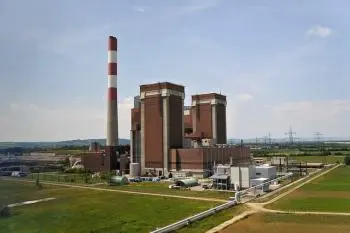
Conventional thermal power plants are plants that produce electricity from a heat source. To generate electrical energy, they obtain thermal energy from fuel (often coal, oil, or natural gas) to produce water vapor. Subsequently, a steam turbine connected to a generator, transforms the steam into electrical energy.
Steam power plants can be divided into several sections:
- Power line.
- Steam production.
- Steam turbine.
- Condenser.
Although the definition of a thermal power plant is quite restrictive, different types of thermodynamic cycles can be observed that satisfy these requirements. The most widespread cycles are Rankine cycles and Hirn cycles.
The most common steam power plants are nuclear power plants, coal power plants, solar thermal power plants and combined cycle power plants.
Combined cycle plants are based on two different thermal machines with separate cycles. On the one hand, it works like a conventional steam power plant and, on the other, by means of a natural gas turbine.
Power line of a steam power plant
Before entering the boiler, the water goes through a preheating and compression phase. When entering the boiler there are several heat exchangers in which the steam coming out of the turbine preheats the working fluid.
This allows higher temperatures to enter the steam generator, resulting in higher plant efficiency.
How is steam generated in a thermal power plant?
In the steam generator of a thermal power plant, the water at constant pressure is brought to the boiling point due to the pressure and at the temperature, the water turns into steam.
This is achieved by means of a properly designed heat exchanger divided into different parts. These can be exchanged with a liquid or with hot gases produced by combustion.
In supercritical systems, the working liquid no longer undergoes a true phase transition. In these systems the pressure is above the critical point.
Steam expansion in plant turbine
The steam coming out of the steam generator is sent to a steam engine. This machine is normally a steam turbine or an alternative machine.
The first part of the expansion often takes place through an initial action stage.
Subsequently, only the reaction stages follow due to their greater efficiency. For large thermal power plants at a certain expansion point, the steam is sent back to the steam generator for reheating. In this way, the work of the turbine is increased and at the same time the presence of condensate in its discharge is reduced.
The steam continues its expansion in the turbine, expanding and cooling.
Once the expansion is complete, the steam leaves the turbine and is sent to the condenser, for simple fluids, or to a desuperheater followed by the condenser, for fluids with a retrograde saturation hood.
The expanded steam that comes out, still has a high temperature and is sent to a heat exchanger with the boiler to start heating the fluid for the next cycle.
What is the function of the capacitor?
The condenser of a thermal power plant is the component in which the condensation of the working fluid takes place to convert it into water.
The condenser works at very low pressures in water cycles, while it can be at higher pressures, even higher than atmospheric pressures, for cycles fed with other working fluids.
How is energy transformed into electricity?
The expansion of the steam in the turbine allows the transfer of mechanical energy to the rotor blades. On the other hand, the rotor is connected to an alternator that absorbs energy. The alternator is a three-phase synchronous generator connected directly to the main electrical system of the power plant and indirectly to the electrical transmission network.
The conversion of mechanical energy into electrical energy is carried out through phenomena of electromagnetic mechanical conversion of the energy present within the alternator.
What is the environmental impact of a steam plant?
The environmental impacts of steam plants is different depending on the way the steam is obtained:
- Thermal power plants that use fossil fuels generate greenhouse gases.
- Nuclear power plants do not emit gases but they generate highly polluting nuclear waste that must follow a very strict storage process.
- Solar thermal power plants use a renewable energy source and have minimal impact.